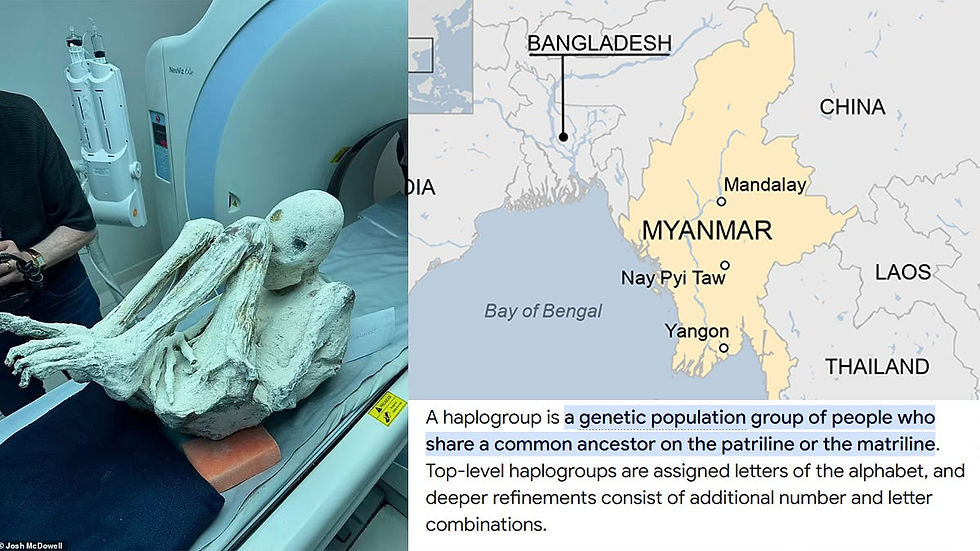RESEARCHERS SILENCED: What Nazca Body Tests ACTUALLY FOUND - Part 5
- Cristina Gomez

- May 12
- 3 min read
Updated: Jul 25
In a revealing interview with Cristina Gomez, veteran journalist Jois Mantilla shared his journey investigating what he describes as “the most important discovery in history” — the controversial Nazca bodies found in Peru. With over three decades of experience in journalism, including coverage of wars, natural disasters, and political upheavals across Latin America, Mantilla has staked his professional reputation on the authenticity of these unusual specimens.
Mantilla’s involvement began in 2017 when the Nazca mummies first appeared on social media. At that time, he had transitioned from his career as a war correspondent to running his own production company creating content for major networks like History Channel. Despite living “very peacefully with important clients,” Mantilla’s journalistic instincts were piqued by the unusual reports coming from his native Peru.

After noticing that Jaime Maussan’s investigative team lacked Peruvian representation, Mantilla reached out via Twitter offering his assistance navigating local customs and connections. He claims he approached the investigation with professional skepticism, even warning Maussan that he would report any attempt to cover up or misrepresent findings. According to Mantilla, he maintained complete editorial independence throughout the investigation, allowing him to document his observations without interference.
The specimens at the center of this controversy possess several anatomical anomalies that Mantilla claims cannot be explained by conventional science. In his presentation he mentioned that most notably, they are tridactyl — having three fingers on each hand — along with eyes angled at approximately 45 degrees, linear fingerprints unlike those of humans or primates, and proportionally larger cranial capacities. Mantilla specifically mentions specimens named “Maria,” “Sebastian,” and “Monserrat,” describing them as preserved beings with intact internal organs covered in a white substance known as diatomaceous earth.

Perhaps the most extraordinary claim involves a specimen carrying a fetus. Mantilla states that CT scans revealed a tiny being within one of the specimens, which he says proves the authenticity of the remains. “This can’t be faked,” Mantilla insists, challenging skeptics to explain how someone could “open a pregnant human mummy, mutilate its fingers to make it tridactyl, and leave no evidence.”

The preservation of these specimens is another point of emphasis in Mantilla’s testimony. He describes a white coating that critics have dismissed as plaster but which he claims is actually diatomaceous earth mixed with cadmium chloride — a toxic substance he says was used as an adhesive in the preservation process. According to Mantilla, this technique has maintained the bodies in remarkable condition for over 1,500 years.
Mantilla expresses frustration with what he characterizes as a coordinated effort by the scientific establishment to discredit the investigation. He claims that without proper examination, scientists rushed to label the specimens as manipulated human remains modified for commercial purposes. In contrast, Mantilla asserts that over 50 professionals have now examined the specimens, including researchers from four Peruvian universities who risk their academic reputations by studying these controversial remains.
The DNA analysis of these specimens represents another extraordinary claim. Mantilla describes the genetic makeup of “Maria” as a “tetra hybrid” containing human DNA, bonobo DNA, “bonobo in transformation” DNA, and an unknown genetic component not found in genetic libraries. He challenges skeptics to explain how such genetic manipulation could have been accomplished 1,800–2,000 years ago when “we can’t even do it now.”

Mantilla also points to historical evidence of tridactyl beings in ancient art across multiple continents. He cites examples from Iraq, Chile, Mexico, California, Australia, and various regions of Peru, including cave paintings allegedly dating back 11,000 years. Even more surprisingly, Mantilla claims that Peru’s own Ministry of Culture has exhibited textile dolls with three fingers in the Museum of Art in Lima, suggesting that the ancients were depicting beings they actually encountered.

The Peruvian government’s response has been dismissive, according to Mantilla. He describes a “pompous press conference” where officials presented confiscated airport handicrafts to discredit the university-based research. “That’s why I jokingly call them doll experts,” Mantilla says, “because they are experts in dolls, they analyze dolls, we analyze desiccated bodies.” He argues that if officials conducted proper examinations at the University of Ica where several specimens are kept, they would find evidence supporting the authenticity of these remains.
Despite facing ridicule and professional risk, Mantilla remains committed to bringing attention to what he considers an unprecedented scientific discovery. He emphasizes that he’s not asking people to accept everything as “absolute and truthful” but rather advocating for continued investigation by leading experts worldwide. His ultimate goal is for the Peruvian government to permit international scientists to examine the specimens at the University of Ica and conduct comprehensive laboratory testing.
What’s clear is that Jois Mantilla, a journalist with decades of experience covering world events, believes he has encountered something that defies conventional explanation — something he considers worth risking his professional reputation to investigate and share with the world.
This article is part 5. Read 1–4 here. https://www.ufonews.co/post/nazca-bodies-drive-global-scientific-investigation-part-1















Comments